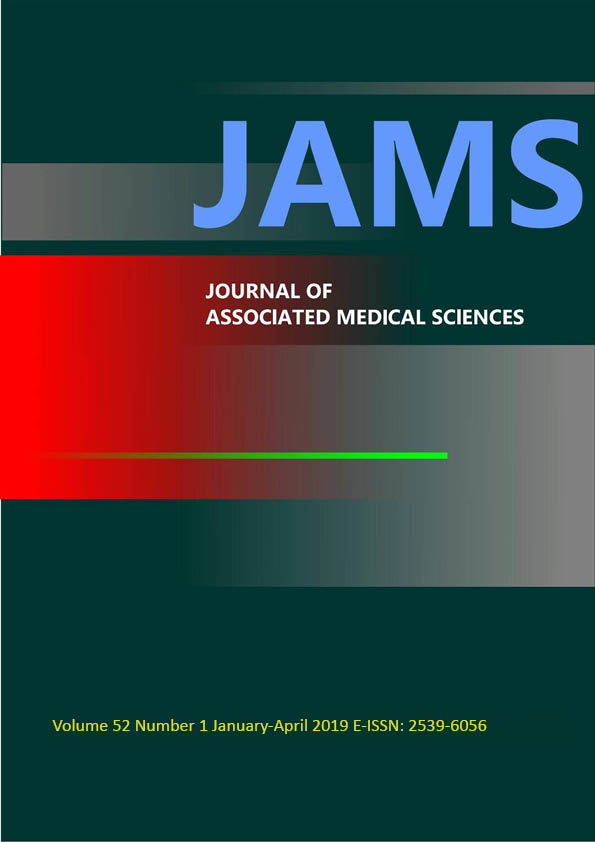Feasibility of high resolution melting curve analysis for rapid serotyping of Salmonella from hospitalised patients
Main Article Content
Abstract
Background: Serum agglutination test is the gold standard phenotyping method widely used for Salmonella enterica characterisation.This conventional method is limited by its complicated and time-consuming procedures. High resolution melting curve (HRM) analysis is introduced as a rapid and labour-saving method.
Objectives: To compare the results of conventional serum agglutination and quantitative PCR-HRM analysis to assess the feasibility of this alternative approach for Salmonella serotyping.
Materials and methods: Salmonella strains from 38 human-originating samples were serotyped using the conventional serum agglutination method and HRM analysis.
Results: The conventional serum agglutination assay detected 14 serotypes, while the HRM analysis identified 10 HRM profiles. There was a correlation between most of the serotyping results obtained by the two methods. Nine of the HRM profiles were unique to a single serotype, of each. One exception was HRM_3. Many of the indistinct curves that were grouped in this HRM pattern belonged to five Salmonella serotypes, including Weltevreden, Corvallis, Derby, Kedougou and Kentucky.
Conclusion: It is difficult to determine all Salmonella serotypes by HRM analysis. However, this method can be used as an alternative to the conventional serum agglutination assay for rapid and labour-saving serotyping.
Article Details

This work is licensed under a Creative Commons Attribution-NonCommercial-NoDerivatives 4.0 International License.
Personal views expressed by the contributors in their articles are not necessarily those of the Journal of Associated Medical Sciences, Faculty of Associated Medical Sciences, Chiang Mai University.
References
[2] Leader BT, Frye JG, Hu J, Fedorka-Cray PJ, Boyle DS. High-throughput molecular determination of Salmonella enterica serovars by use of multiplex PCR and capillary electrophoresis analysis. J Clin Microbiol 2009; 47(5): 1290-9.
[3] Lopes GV, Michael GB, Cardoso M, Schwarz S. Antimicrobial resistance and class 1 integron-associated gene cassettes in Salmonella enterica
serovar Typhimurium isolated from pigs at slaughter and abattoir environment. Vet Microbiol 2016; 194: 84-92.
[4] Bangtrakulnonth A, Pornreongwong S, Pulsrikarn C, Sawanpanyalert P, Hendriksen RS, Lo Fo Wong DM., et al. Salmonella serovars from humans and other sources in Thailand, 1993-2002. Emerg Infect Dis 2004; 10(1): 131–6.
[5] Popoff MY, Bockemuhl J, McWhorter-Murlin A. Supplement 1991 (no. 35) to the Kauffmann-White scheme. Res Microbiol 1992; 143(8): 807-11.
[6] Sirichote P, Bangtrakulnonth A, Tianmanee K, Unahalekhaka A, Oulai A, Chittaphithakchai P, et al. Serotypes and antimicrobial resistance of Salmonella enterica spp. in central Thailand, 2001-2006. Southeast Asian J Trop Med Public Health 2010; 41(6): 1405-1415.
[7] Herikstad H, Motarjemi Y, Tauxe RV. Salmonella surveillance: a global survey of public health serotyping. Epidemiol Infect 2002; 129(1): 1–8.
[8] Chuanchuen R, Ajariyakhajorn K, Koowatananukul C, Wannaprasat W, Khemtong S, Samngamnim S. Antimicrobial resistance and virulence genes in Salmonella enterica isolates from dairy cows. Food-borne Pathog Dis 2010; 7(1): 63-9.
[9] Foley SL, Lynne AM, Nayak R. Salmonella challenges: prevalence in swine and poultry and potential pathogenicity of such isolates. J Anim Sci 2008; 86 (14 Suppl): E149-62. doi: 10.2527/jas.2007-0464
[10] Grimont PAD, Weill FX. Antigenic formulas of the Salmonella serovar. 9th ed. Paris: Institut Pasteur; 2007.
[11] International Standard Organization. Microbiology of food and animal feeding stuffs - Horizontal method for the detection of Salmonella spp. 4th ed. Geneva: ISO; 2002.
[12] Alvarez J, Sota M, Vivanco AB, Perales I, Cisterna R, Rementeria A, et al. Development of a multiplex PCR method for detection and epidemiological typing of Salmonella in human clinical samples. J Clin Microbiol 2004; 42(4): 1734-8.
[13] Zeinzinger J, Pietzka AT, Stöger A, Kornschober C, Kunert R, Allerberger F. One-step triplex high-resolution melting analysis for rapid identification and simultaneous subtyping of frequently isolated
Salmonella serovars. Appl Environ Microbiol 2012; 78(9): 3352-3360.
[14] Cheng HR, Jiang N. Extremely rapid extraction of DNA from bacteria and yeasts. Biotechnol Lett 2006; 28(1): 55-9
[15] Hunter PR, Gaston MA. Numerical index of the discriminatory ability of typing system: an application of Simpson’s index of diversity. J Clin Microbial 1988; 26(11): 2465-6.
[16] Fowlkes EB, Mallows CL. A method for comparing two hierarchical clusterings. J Am Stat Assoc 1983; 78(383): 553-69.
[17] Bereau of Epidemiology, Thailand. 2017. National Disease Surveillance (Report 506): Food poisoning 2017 [internet]. [Place unknown]: Bereau of Epidemiology; 2017 [cite 2018 April 8]. Available
from: https://www.boe.moph.go.th/boedb/surdata/506wk/y60/d03_5360.pdf.
[18] Huoy L, Pornruangwong S, Pulsrikarn C, Chaturongakul S. Molecular characterization of Thai Salmonella enterica serotype Typhimurium and serotype 4,5,12:i:- reveals distinct genetic deletion pat-terns. Foodborne Pathog Dis 2014; 11(8): 589-92.
[19] Tadee P, Boonkhot P, Pornruangwong S, Patchanee P. Comparative phenotypic and genotypic characterization of Salmonella spp. in pig farms and slaughterhouses in two provinces in northern Thailand. Plos One 2015; 10(2): e0116581. doi: 10.1371/journal.pone.0116581.
[20] Hendriksen RS, Hello SL, Bortolaia V, Pulsrikarn C, Nielsen EM, Pornruangmong S, et al. Characterization of isolates of Salmonella enterica Serovar Stanley, a serovar endemic to asia and associated with travel. J Clin Microbiol 2012; 50(3): 709-20.
[21] Padungtod P, Kaneene JB. Salmonella in food animals and humans in northern Thailand. Int J Micro-biol 2006; 108(3): 346-54.
[22] O’Regan E, McCabe E, Burgess C, McGuinness S, Barry T, Duffy G, et al. Development of a real-time multiplex PCR assay for the detection of multiple Salmonella serotypes in chicken samples. BMC Mi-crobiol. 2002; 8: 156. doi: 10.1186/1471-2180-8-156.
[23] Ren X, Fu Y, Xu C, Feng Z, Li M, Zhang L, et al. High resolution melting (HRM) analysis as a new tool for rapid identification of Salmonella enterica serovar Gallinarum biovars Pullorum and Gallinarum. Poult Sci 2017; 96(5): 1088-93.


